Philips M5066A User Manual
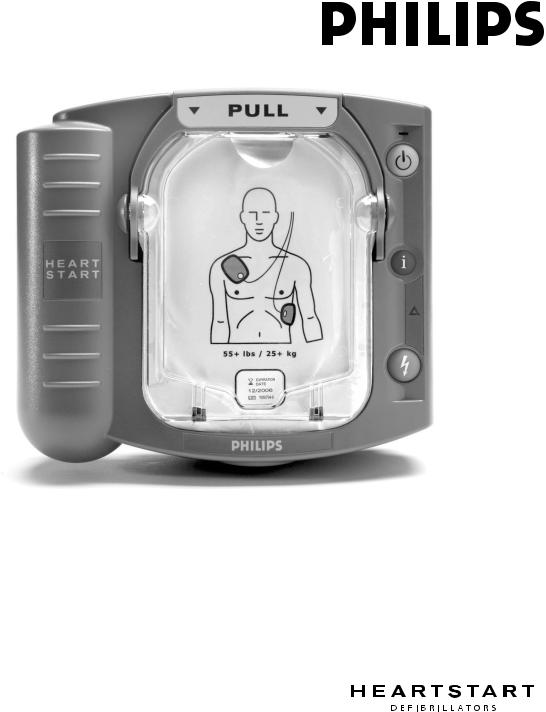
H e a r t S t a r t D e f i b r i l l a t o r
O W N E R ’ S M A N U A L
Guide to Set Up, Operation, Maintenance, and Accessories
M5066A
Edition 7
Intentionally blank.
Systems Medical Philips
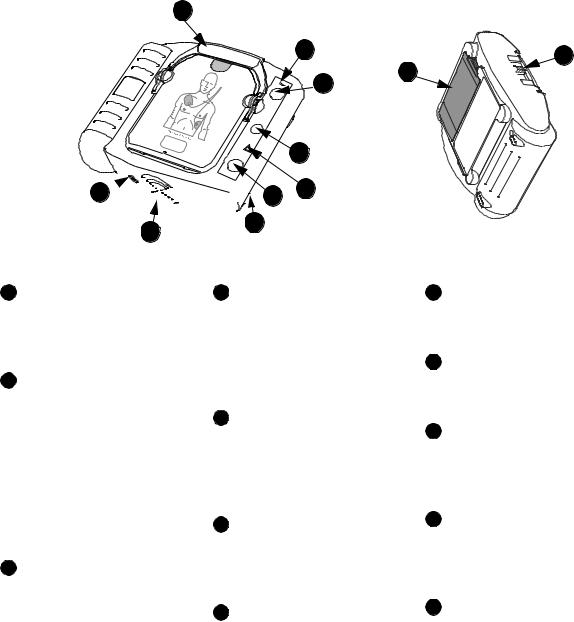
Philips Medical Systems
front view |
A |
|
|
top |
back view |
||
|
|||
|
|
top
B
K
L
C
D
I 











 F E
F E
G
H
The HeartStart Defibrillator M5066A
A  Pads Cartridge Handle.
Pads Cartridge Handle.
Pull the handle to turn on the
HeartStart and remove the
cartridge’s hard cover.
B  Ready Light. This green light
Ready Light. This green light
tells you the readiness of the
HeartStart.
Blinking: |
standby mode |
|
(ready for use) |
Solid: |
in use |
Off: |
needs attention |
|
(HeartStart |
|
“chirps” and |
|
i-button flashes) |
C  On/Off Button. Press this green button
On/Off Button. Press this green button  to turn on the HeartStart. To turn off the HeartStart, press the green button again and hold it down for one (1) second.
to turn on the HeartStart. To turn off the HeartStart, press the green button again and hold it down for one (1) second.
D Information Button. This blue “i-button”
Information Button. This blue “i-button”  flashes when it has information you can access by pressing it. It also flashes at the beginning of a patient care pause when CPR coaching is enabled.
flashes when it has information you can access by pressing it. It also flashes at the beginning of a patient care pause when CPR coaching is enabled.
E  Caution Light. This triangular light
Caution Light. This triangular light  flashes during rhythm analysis and is on when a shock is advised, as a reminder that no one should be touching the patient.
flashes during rhythm analysis and is on when a shock is advised, as a reminder that no one should be touching the patient.
F  Shock Button. When instructed by the HeartStart to deliver a shock, press this flashing orange button
Shock Button. When instructed by the HeartStart to deliver a shock, press this flashing orange button  .
.
G Infrared (IR) Communications Port. This special lens, or “eye,” is used to transfer HeartStart data directly to or from a computer.
Infrared (IR) Communications Port. This special lens, or “eye,” is used to transfer HeartStart data directly to or from a computer.
H Speaker. When the device is being used, its voice instructions come from this speaker.
Speaker. When the device is being used, its voice instructions come from this speaker.
I  Beeper. The HeartStart “chirps” through this beeper to alert you when it needs attention.
Beeper. The HeartStart “chirps” through this beeper to alert you when it needs attention.
J  SMART Pads Cartridge. This
SMART Pads Cartridge. This
disposable cartridge contains self-
adhesive pads with attached cable.
Shown with adult pads cartridge.
K  SMART Pads Cartridge Latch. Slide the latch to the right to release the pads cartridge for replacement.
SMART Pads Cartridge Latch. Slide the latch to the right to release the pads cartridge for replacement.
L  Battery. The nonrechargeable battery is inserted in a recess on the back of the HeartStart.
Battery. The nonrechargeable battery is inserted in a recess on the back of the HeartStart.
Intentionally blank.
Systems Medical Philips
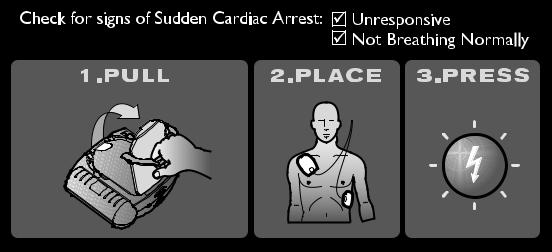
HeartStart Defibrillator M5066A
QUICK REFERENCE
Philips Medical Systems
Intentionally blank.
Systems Medical Philips

HeartStart
M5066A
Automated External Defibrillator
O W N E R ’ S M A N U A L
Edition 7
IMPORTANT NOTE:
It is important to understand that survival rates for sudden cardiac arrest are directly related to how soon victims receive treatment. For every minute of delay, the chance of survival declines by 7% to 10%.
Defibrillation cannot assure survival. In some victims, the underlying problem causing the cardiac arrest is simply not survivable despite any available care.
Philips Medical Systems
Intentionally blank.
Systems Medical Philips
About this edition
The information in this guide applies to
the model M5066A HeartStart Defibrillator. Its technical contents apply to all models
in the HeartStart HS1 family of defibrillators, including the HeartStart, the HeartStart OnSite, and the HeartStart First Aid Defibrillator. This information is subject to change. Please contact Philips at www.medical.philips.com/heartstart or contact your local Philips representative for information on revisions.
Edition history
Edition 7
Publication date: July 2007
Publication #: M5066-91901
Assembly #: 011872-0007
Printed in the U.S.A.
Copyright
© 2007 Philips Electronics North America Corp.
No part of this publication may be reproduced, transmitted, transcribed, stored in a retrieval system or translated into any human or computer language in any form by any means without the consent of the copyright holder.
Unauthorized copying of this publication may not only infringe copyright but also reduce the ability of Philips Medical Systems to provide accurate and up-to-date information to users and operators alike.
Authorized EU representative
Philips Medizin Systeme Boeblingen GmbH Hewlett-Packard Strasse 2
71034 Boeblingen, Germany
(+49) 7031 463-2254
CAUTION: Federal law (USA) restricts this device to sale by or on the order of a physician.
The Philips HeartStart Defibrillator is designed to be used only with Philips-approved accessories. The HeartStart may perform improperly if nonapproved accessories are used.
Device tracking
In the U.S.A., this device is subject to tracking requirements by the manufacturer and distributors. If the defibrillator has been sold, donated, lost, stolen, exported, or destroyed, notify Philips Medical Systems or your distributor.
Device manufacturer
The HeartStart Defibrillator is manufactured by Philips Medical Systems, Seattle, Washington, USA.
Patents
This product is manufactured and sold under one or more of the following United States patents: US6047212, US6317635, US5892046, US5891049, US6356785, US5650750, US6553257, US5902249, US6287328, US6662056, US5617853, US5951598, US6272385, US6234816, US6346014, US6230054, US6299574, US5607454, US5803927, US5735879, US5749905, US5601612, US6441582, US5889388, US5773961, US6016059, US6075369, US5904707, US5868792, US5899926, US5879374, US5632280, US5800460, US6185458, US5611815, US6556864, US5607454, and other patents pending.
Systems Medical Philips
HEARTSTART M5066A
Intentionally blank.
Systems Medical Philips

Philips Medical Systems
CONTENTS
1 Introduction to the HeartStart
|
Description ........................................................................................................... |
1-1 |
|
Sudden Cardiac Arrest ....................................................................................... |
1-1 |
|
Indications for Use .............................................................................................. |
1-1 |
|
Training and practice .......................................................................................... |
1-2 |
|
National and local requirements ...................................................................... |
1-2 |
|
For more information ......................................................................................... |
1-2 |
2 Setting up the HeartStart |
|
|
|
Package contents ................................................................................................. |
2-1 |
|
Setting up the HeartStart ................................................................................... |
2-1 |
|
Recommended accessories ............................................................................... |
2-3 |
3 |
Using the HeartStart |
|
|
Overview ............................................................................................................... |
3-1 |
|
STEP 1: PULL the green handle ........................................................................ |
3-2 |
|
STEP 2: PLACE the pads .................................................................................... |
3-3 |
|
STEP 3: PRESS the Shock button ..................................................................... |
3-3 |
|
Treating infants and children ............................................................................ |
3-4 |
|
When emergency medical services arrive ..................................................... |
3-6 |
4 After using the HeartStart |
|
|
|
After each use ...................................................................................................... |
4-1 |
|
HeartStart data storage ..................................................................................... |
4-1 |
5 |
Maintaining the HeartStart |
|
|
Routine Maintenance .......................................................................................... |
5-1 |
|
Periodic checks .................................................................................................... |
5-1 |
|
Cleaning the HeartStart ..................................................................................... |
5-2 |
|
Disposing of the HeartStart .............................................................................. |
5-2 |
|
Troubleshooting tips ........................................................................................... |
5-2 |
i
APPENDICES
AAccessories for the HeartStart
BGlossary of terms
CGlossary of symbols/controls
DWarnings and precautions
ETechnical information
FConfiguration
GTesting and troubleshooting
HAdditional technical information required for European conformity
ii
Systems Medical Philips
HEARTSTART M5066A

Philips Medical Systems
1
1 Introduction to the HeartStart
Description
The HeartStart Defibrillator M5066A is part of the Philips HeartStart HS1 family of defibrillators. Small, lightweight, and battery powered, it is designed for simple and reliable operation.
Sudden Cardiac Arrest
The HeartStart is used to treat the most common causes of sudden cardiac arrest (SCA), including ventricular fibrillation (VF). SCA is a condition that occurs when the heart unexpectedly stops pumping. SCA can occur to anyone – infant, child, adult, male or female – anywhere, at any time. Many victims of SCA do not have warning signs or symptoms.
VF is a chaotic quivering of the heart muscle that prevents it from pumping blood. The only effective treatment for VF is defibrillation. The HeartStart treats VF by sending a shock across the heart, so it can start beating regularly again. Unless this is successful within the first few minutes after the heart stops beating, the victim is not likely to survive.
Indications for Use
The HeartStart should be used to treat someone you think may be a victim of SCA. A person in SCA:
•does not respond when shaken, and
•is not breathing normally.
If in doubt, apply the pads. Follow the voice instructions for each step in using the defibrillator.
1-1

1-2
Training and practice
The HeartStart is one part of a well-designed emergency response plan. Any emergency response plan should be under the oversight of a physician and should include training in cardiopulmonary resuscitation (CPR). Philips recommends that you train on the device you will be using.
Several national and local organizations offer combined CPR/defibrillator training.
Contact your Philips representative, or visit us on-line at
www.medical.philips.com, for information about training programs in your area.
NOTE: Training accessories are available from Philips for practicing use of the
HeartStart. See Appendix A for information on ordering accessories.
National and local requirements
Check with your local health department to see if there are any national or local requirements about owning and using a defibrillator.
For more information
Contact your local Philips representative for additional information about the HeartStart. They will be happy to answer any questions you may have and to provide you with copies of the clinical summaries of several key studies using Philips automated external defibrillators.*
You can also find the clinical summaries online at www.medical.philips.com/ heartstart. Technical information about all Philips HeartStart automated external defibrillators is also available online, in the Technical Reference Guide for HeartStart Defibrillators.
* Clinical summaries also include Heartstream ForeRunner and FR2 Defibrillators.
Systems Medical Philips
HEARTSTART M5066A

Philips Medical Systems
2 Setting up the HeartStart
2
Package contents
Check the contents of the HeartStart Defibrillator M5066A box to be sure it contains:
•1 HeartStart Defibrillator
•1 battery M5070A
•1 Adult SMART Pads Cartridge M5071A, containing one set of adhesive defibrillation pads
•1 Owner’s Manual
•1 Quick Reference Guide
Training materials and optional accessories for the HeartStart are also available from Philips. See Appendix A for a description of these items.
Setting up the HeartStart
Setting-up the HeartStart Defibrillator is simple and quick.
1.Remove the HeartStart from its packaging.
2.Remove a new SMART Pads Cartridge from its package.*
* To replace a used cartridge or insert a different cartridge, first locate the latch at the top edge of the defibrillator, and slide it to the side. The pads cartridge will be released. Lift out the cartridge and replace as described in steps 2 and 3.
2-1
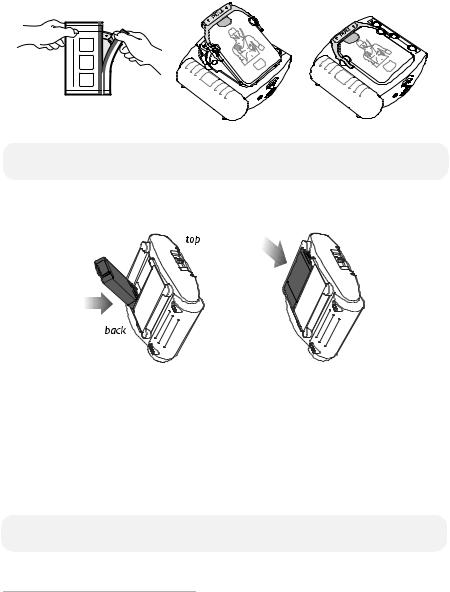
2-2
3.Insert the cartridge into the cartridge well on the front of the defibrillator. It should click into place when properly seated. The green PULL handle should be all the way down.
NOTE: To prevent the pads’ adhesive gel from drying out, do not open the hard cover or film seal of the cartridge until you need to use the pads.
4.Remove the battery from its packaging. Install it in the battery compartment on the back of the defibrillator.
Systems Medical Philips
5.The HeartStart will automatically run a self-test when the battery is inserted. Press the Shock button when instructed. When the self-test is over, the defibrillator will report the result, and tell you to push the green On/Off button in case of an emergency. (Do not push the green button unless this is an actual emergency.) Then the defibrillator will turn off and go to standby mode.
The green Ready light will be blinking to show the HeartStart is ready for use.*
NOTE: Always store the HeartStart with a pads cartridge and a battery installed, so it will be ready to use and can perform daily self-tests.
*As long as a battery is installed, turning the HeartStart “off” puts it into standby mode, which means that it is ready for use.
HEARTSTART M5066A

Philips Medical Systems
2-3
6.Place the defibrillator in the carry case, pressing it firmly into place. Insert the
Quick Reference Guide,* face up, in the clear plastic window on the inside of the case. If you purchased a spare SMART Pads Cartridge or an Infant/Child
Pads Cartridge, place it in the storage area in the case.
2
NOTE: Do not store anything in the defibrillator carry case that it is not designed to accommodate. Store all objects in their intended location in the case.
7.Store the HeartStart in accordance with your site’s emergency response protocol. Typically, this will be in a high-traffic area that is easy to access, convenient for checking the Ready light periodically, and easy to hear the alarm chirp if the battery power gets low or the defibrillator needs attention. Ideally, the HeartStart should be stored near a telephone, so the Emergency Response Team or Emergency Medical Services can be alerted as fast as possible in the event of a possible SCA. If possible, keep the spare SMART Pads Cartridge and other accessories with the defibrillator – in the carry case if one is used – for quick access when needed. In general, treat the HeartStart as you would any piece of electronic equipment, such as a computer. Be sure to store the defibrillator according to its specifications. See Appendix E for details. As long as a battery and a pads cartridge are installed, the green Ready light should be blinking to show that the HeartStart has passed its most recent self-test and is therefore ready to use.
NOTE: If you have a training pads cartridge, it is recommended that you
store it separately from the HeartStart, so the training pads cannot be confused with the regular pads in an emergency.
*The illustration on the cover of the Quick Reference Guide is a 3-step guide to using the HeartStart. Detailed illustrated directions are inside, for reference in an emergency, or if you are hearing impaired or using the HeartStart where it is hard to hear the voice instructions.
2-4
Recommended accessories
It is always a good idea to have a spare battery and a spare pads set. Other things that are useful to keep with the HeartStart include:
•scissors — for cutting the victim’s clothes if needed
•disposable gloves — to protect the user
•a disposable razor — to shave the chest if hair prevents good pads contact
•a pocket mask or face shield — to protect the user
•a towel or absorbent wipes — to dry the victim's skin for good pads contact
Philips has a Fast Response Kit with all these items. See Appendix A for details.
If you may need to defibrillate an infant or a child under 25 kg (55 pounds) or 8 years old, it is recommended that you order the Infant/Child SMART Pads Cartridge, available separately. When the Infant/Child Pads Cartridge is installed in the HeartStart, the HeartStart automatically reduces the defibrillation energy to an energy level more appropriate for infants and children. In addition, if optional CPR coaching is selected, the HeartStart provides coaching appropriate for infants and children. Directions for using the Infant/Child SMART Pads are provided in Chapter 3, “Using the HeartStart.”
Systems Medical Philips
HEARTSTART M5066A

Philips Medical Systems
3 Using the HeartStart
IMPORTANT NOTE: Be sure to read the Reminders section at the end of this chapter as well as the warnings and precautions in Appendix D.
Overview
If you think someone is in SCA, act quickly and calmly. If someone else is available, |
3 |
|
|
ask him or her to call for emergency medical assistance while you get the |
|
HeartStart. If you are alone, follow these steps: |
|
•Call your emergency services provider.
•Quickly get the HeartStart and bring it to the victim’s side. If there is any delay in getting the defibrillator, check the patient and perform cardiopulmonary resuscitation (CPR) if needed until the HeartStart is available.
•If the patient is an infant or child, first perform CPR, then call for emergency medical services (EMS) before you apply the HeartStart. See special section on treating infants and children on page 3-5.
•Check the immediate environment for flammable gases. Do not use the HeartStart in the presence of flammable gases, such as an oxygen tent. However, it is safe to use the HeartStart on someone wearing an oxygen mask.
There are three basic steps to using the defibrillator to treat someone who may be in sudden cardiac arrest:
1.PULL up the handle on the SMART Pads Cartridge.
2.PLACE the pads on the patient’s bare skin.
3.PRESS the flashing Shock button  if instructed.
if instructed.
The following pages provide details about each step.
3-1
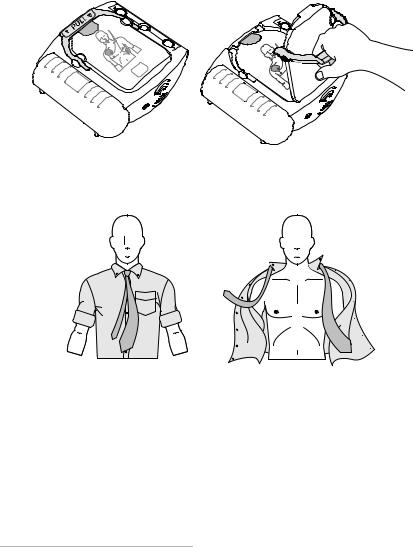
3-2
STEP 1: PULL the green handle
Turn on the HeartStart by pulling the SMART Pads Cartridge’s green handle.*
Remove the hard cover from the pads cartridge and set it aside. Remain calm and follow the HeartStart’s instructions.
The HeartStart starts by directing you to remove all clothes from the patient’s chest. If necessary, rip or cut off the clothing to bare the person’s chest
* You can also turn on the HeartStart Defibrillator by pressing the green On/Off button.
Systems Medical Philips
HEARTSTART M5066A
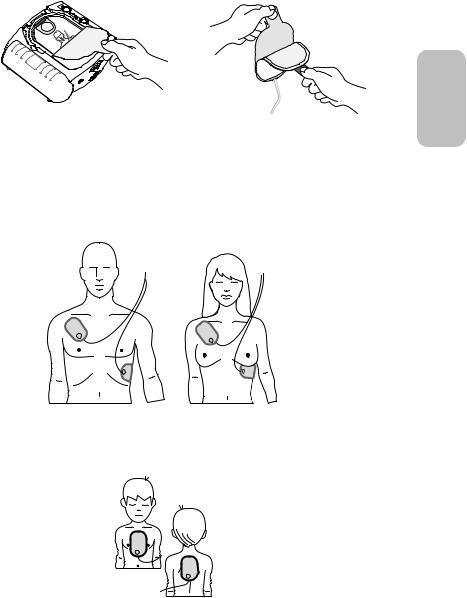
Philips Medical Systems
3-3
STEP 2: PLACE the pads
Pull the tab at the top of the pads cartridge to peel off the film seal. Inside are two
adhesive pads on a plastic liner. Remove the pads from the cartridge.
3
Peel one pad off the liner. Place the pad on the patient’s bare skin, exactly as shown
in the picture on the pad. Press the pad down firmly. Then repeat this with the other
pad. Be sure the pads have been removed from the liner before placing them.
Where to place pads on adults and children over 25 kg/55 pounds or 8 years old (anterior-anterior).
Where to place pads on infants or children under 25 kg/55 pounds or 8 years old (anterior-posterior).
